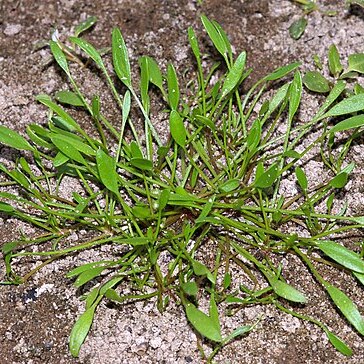Herbs, dwarf, aquatic or terrestrial, cespitose, creeping, or floating. Stolons rooting from nodes or acaulescent. Leaves fascicled, opposite, or alternate on elongated branches, long petiolate. Flowers axillary, minute, short pedicellate. Bracteoles absent. Calyx campanulate, 5-lobed. Corolla radiate-campanulate, regular; tube short; lobes 5, subequal. Stamens 4, equal, inserted near middle of corolla tube; filaments filiform; anthers confluent, 1-loculed. Ovary basally 2-loculed. Style short; stigma capitate. Capsule indistinctly dehiscent. Seeds numerous, ovoid, small; seed coat rugose.
Cal campanulate, equally 5-lobed; cor campanulate, regular, the 5 lobes shorter than the tube; stamens 4; pollen-sacs confluent into 1; stigma solitary and ± capitate; fr septicidal; seeds many; small annuals, the stems prostrate, at each node emitting roots, a cluster of basal lvs, and few–several basal, 1-fld peduncles; cor minute, white or suffused with pink. 15, nearly cosmop.
Leaves radical or fasciculate at nodes, rarely alternate on stems or branches, petiolate, erect or floating; lamina linear and petiole-like, spathulate or oblong-ovate.
Corolla tubular, campanulate, subrotate; limb 5-lobed, spreading, lobes subequal, rounded, ovate or oblong.
Stamens four, didynamous, usually exserted; filaments filiform, inserted on corolla tube.
Peduncles axillary, ebracteate, of ten shorter than leaves, frequently deflexed in fruit.
Ovary shortly bilocular at base; ovules many; style short, incurved, apically thickened.
Fruit capsular, ovoid to subglobose or spherical, bivalved, loculicidally dehiscent.
Small, glabrous, tufted, creeping or floating, marsh or aquatic herbs.
Stemless or with slender stolon-like stems rooting at nodes.
Calyx campanulate, thin, (4)5-lobed, persistent.
Seeds numerous, striate, rugulose.
Flowers small.

